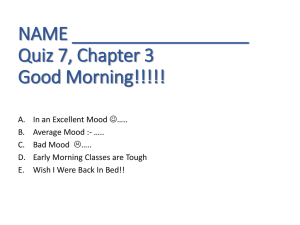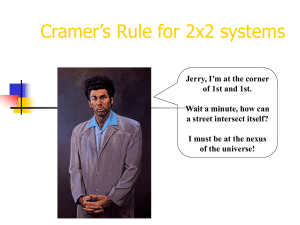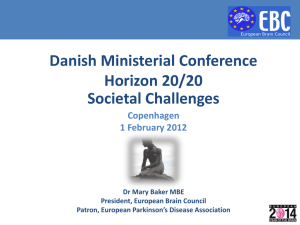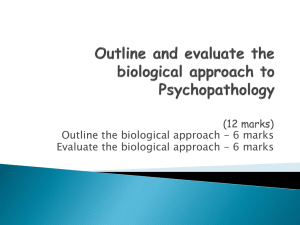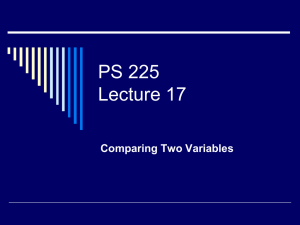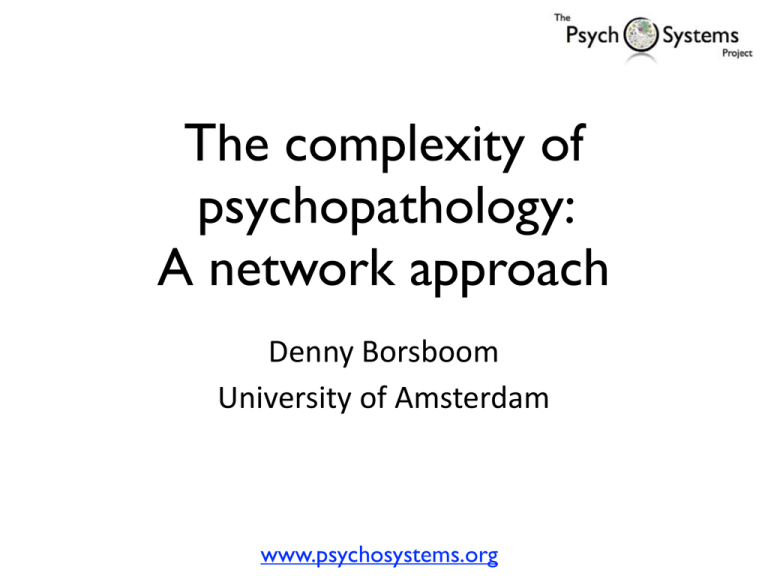
The complexity of
psychopathology: !
A network approach
Denny%Borsboom%
University%of%Amsterdam
www.psychosystems.org
Overview
• The network idea!
• Conceptual consequences:!
• Disorders and their boundaries!
• Kinds or categories!
• The particular and the general!
• Discussion
The standard model
error
mood
error
error
sleep
interest
Depression
Reductionist daydreams
Great expectations, limited
yields
• Research%into%the%“biological%basis”%for%disorders%
has%proven%exceptionally%tricky%
• Limited%advances%in%pinpointing%neurobiological%
correlates,%let%alone%causes%
• Genetic%findings%suggest%no%large%and%specific%
genetic%effects%for%common%mental%disorders%
• Also%note%that%although%medication%prescription%
has%risen%spectacularly,%prevalence%is%relatively%
constant
The network alternative
sleep
tired
conc
worry
I: Disorders and their
boundaries
What magnetism and
depression have in common
8
fal
X1 = 1
X5 = 1
X9 = 1
sle
X13 = 1
wak
pan
sen
hyp
anx
X2 = 1
X6 = 1
X10 = 1
X14 = − 1
fut
irr
bod
mod
sui
sad
sel
res
qmo
X3 = − 1
X7 = − 1
X11 = − 1
con
X15 = − 1
rmo
ple
par
ene
dig
int
X4 = 1
X8 = 1
X12 = 1
ach
X16 = 1
slo
app
sex
wei
fal: falling asleep
sle: sleep during the night
wak: waking up too early
hyp: hypersomnia
sad: feeling sad
irr: feeling irritable
anx: feeling anxious
rmo: respons of mood to events
mod: mood in relation to time of day
qmo: quality of mood
app: change of appetite
wei: change of weight
con: concentration problems
sel: view of oneself
fut: view of future
sui: suicidal thoughts
int: general interest
ene: energy level
ple: capacity for pleasure (not sex)
sex: interest in sex
slo: feeling slowed down
res: feeling restless
ach: aches/pains
bod: other bodily symptoms
pan: panic/phobic symptoms
dig: digestion problems
sen: interpersonal sensitivity
par: leaden paralysis
(b)
e repressented by a network shaped as a lattice as in
is alligned upwards and ≠1 indicates that the south
(b) adheres to a PMRF in that the probability of a
only dependent on the state of its direct neighbors.
only depends on the direct neighbors (north, south
Figure 1: Network constructed with `1 regularized logistic regression of each
variable on the other variables. Neighborhood selection is optimized with
EBIC.
Ising model for the entire
DSM-IV
4
9
8
14
3
3
6
17
2
6
3
15
4
5
4
1
9
5
1
2
7
2
5
7
8
12
4
1
3
Mania or hypomania
7
3
13
9
9
3
7
8
Agoraphobia
6
3
4
5
4
19
5
18
17
1
7
11
1
18
13
3
8
3
14
12
10
2
5
4
12
16
2
6
15
13
9
3
1
9
Attention-deficit/hyperactivity disorder
Alcohol abuse or dependence
4
14
11
Post-traumatic stress disorder
2
1
2
2
8
2
4
5
2
1
4
3
1
17
Specific phobia
Panic disorder
3
5
16
10
4
5
8
1
6
Social phobia
4
15
Generalised anxiety disorder
1
7
6
6
10
3
2
10
2
11
12
11
Dysthymia
7
8
4
7
Major depressive episode
6
10
5
1
5
13
10
7
1
16
2
6
Nicotine dependence
Psychotic symptoms
So...
• From a network perspective, boundaries
between disorders are inherently fuzzy!
• Excessive comorbidity cannot be avoided,
as it is inherent in the structure of the
network!
• This may imply that diagnostic practice
should be revised (no more “diagnostic
silos”)
II: Mental disorders:
Kinds or continua?
Diathesis-stress
• Two ways we can manipulate a network:!
• by putting the network under stress:
activating and deactivating symptoms!
• by changing network vulnerability
(diathesis): increasing and decreasing
connectivity strength
LOW
Connectivity
MEDIUM
Connectivity
HIGH
Connectivity
So...
• From a network perspective, the “kinds or
continua” question is misguided!
• Networks can behave as kinds or as
continua, depending on their parameters!
• Many possible extensions: early warnings,
dynamical systems models, other
constructs
III: Personalized
networks
C
P
E
F
D
T
!"#$%&%! + "' (')$*'%+
"+ (+)$*' + ... + #!
H
Bringmann, L.,Vissers, N., Wichers, M., Geschwind, N., Kuppens, P.,
Peeters, F., Borsboom, D., & Tuerlinckx, F. (2013). A network
approach to psychopathology: New insights into clinical longitudinal
data. PLoS ONE.!
When qualitatively analyzing the network structure, it may be concluded that the data of this
Patient 1 (diagnosed
with panic disorder)
patient seem to group in two clusters, which can be labeled as a positive and a negative
cluster. The positive cluster assembles the variables feeling excited and relaxed, being
physically active, having pleasant daily experiences and a pleasant social environment. The
negative cluster assembles feeling tired, depressed and stressed, physical inconvenience, and
unpleasant experiences. Being excited seems to have a bridge function between these two
clusters. Feeling excited often co-occurs with feeling less tired, stressed, and depressed,
whereas physical activity and pleasant daily experiences are associated with feeling excited.
Visualizing the lag-1 correlation matrix of the same patient showed the following
weighted graph in Figure 4.
Figure 4. Lag-1 correlation network of Patient 1.
Patient 2 (diagnosed
with depression)
Version: October 2013
between mood and context, and thus less autonomous mood processes, than in the first
measurement period. Physical activity is still not significantly related to e.g. mood.
The lag-1 correlation network of the second measurement period is shown in Figure 10.
Figure 10. Lag-1 correlation network of Patient 3 during the second measurement period.
Early warnings?
So...
• From a network perspective, the “general”
structure of mental disorders may be an
amalgam of individual patterns!
• Because structure and dynamics are
coupled in networks, such individual
differences can have large consequences!
• This may help in identifying targets for
intervention
Discussion
• Network approaches change the
conceptualization of disorders, and
hence nature of the research game!
• Networks motivate the study of
feedback and interconnection, rather
than a search for latent “diseases”!
• The holistic nature of network
modeling de-emphasizes searches for
“the” genes or “the” neural correlates
of disorders
People
•
Psychosystems group: Angélique Cramer, Verena Schmittmann, Lourens Waldorp, Sacha Epskamp, Claudia van Borkulo,
Mijke Rhemtulla; Collaborators: Laura Bringmann, Arjen Noordhof, Francis Tuerlinckx, Sophie van der Sluis, Kenneth
Kendler, Steve Aggen, Hilde Geurts, Marieke Wichers, Erik Giltay, Han van der Maas, Marten Scheffer, Ingrid van de
Leemput, Gunter Maris, Robert Schoevers. Students: Noémi Schuurman, Robert Hillen, Michel Nivard, Susanna
Gerritse, Janneke de Kort, Charles Driver, Laura Ruzzano, Esther Lietaert-Peerbolte, Jonas Dalege, Jolanda
Kossakowski, Tessa Blanken
Papers
•
•
Borsboom, D., & Cramer, A. O. J. (2013). Network analysis. Annual Review of Clinical Psychology.!
•
Cramer, A. O. J., Borsboom, D., Aggen, S. H., & Kendler, K. S. (2011). The Pathoplasticity of Major Depression.
Psychological Medicine.!
•
•
•
•
•
Bringmann, L.,Vissers, N., Wichers, M., Geschwind, N., Kuppens, P., Peeters, F., Borsboom, D., & Tuerlinckx, F. (2013). A
network approach to psychopathology: New insights into clinical longitudinal data. PLoS ONE.!
Borsboom, D., Cramer, A. O. J., Schmittmann,V. D., Epskamp, S., & Waldorp, L. J. (2011). The small world of
psychopathology. PLoS ONE.!
Schmittmann,V. D., Cramer, A. O. J., Waldorp, L. J., Epskamp, S., Kievit, R. A., & Borsboom, D. (2011). Deconstructing the
construct: A network perspective on psychological phenomena. New Ideas in Psychology.!
Cramer, A.O.J., Waldorp, L.J.,Van der Maas, H.L.J., & Borsboom, D. (2010). Comorbidity: A network approach.
Behavioral and Brain Sciences, 33, 137-193.!
Borsboom, D. (2008). Psychometric perspectives on diagnostic systems. Journal of Clinical Psychology, 64, 1089-1108.
Software
Epskamp, S., Cramer, A. O. J., Waldorp, L. J., Schmittmann,V. D., & Borsboom, D. (2011). qgraph: Network
representations of relationhips in data. R package version0.4.10. Available from http://CRAN.R-project.org/
package=qgraph.
dennyborsboom@gmail.com
www.psychosystems.org

